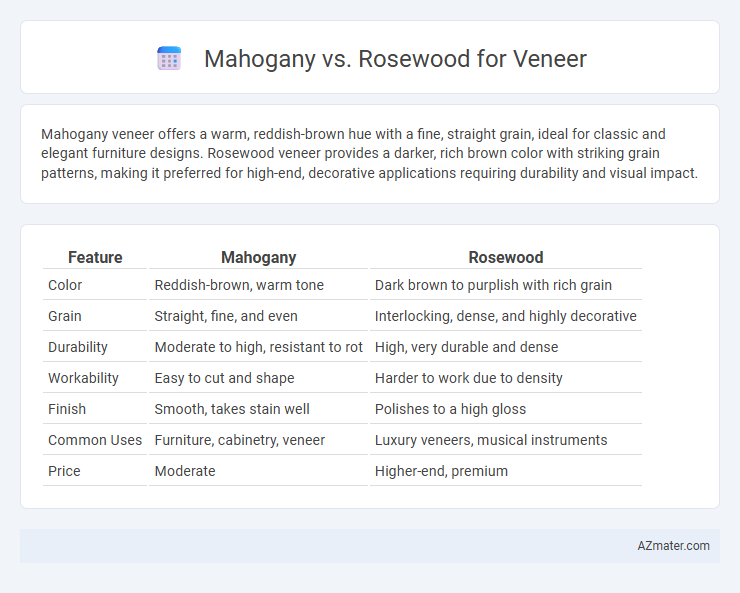Mahogany veneer offers a warm, reddish-brown hue with a fine, straight grain, ideal for classic and elegant furniture designs. Rosewood veneer provides a darker, rich brown color with striking grain patterns, making it preferred for high-end, decorative applications requiring durability and visual impact.
Table of Comparison
| Feature | Mahogany | Rosewood |
|---|---|---|
| Color | Reddish-brown, warm tone | Dark brown to purplish with rich grain |
| Grain | Straight, fine, and even | Interlocking, dense, and highly decorative |
| Durability | Moderate to high, resistant to rot | High, very durable and dense |
| Workability | Easy to cut and shape | Harder to work due to density |
| Finish | Smooth, takes stain well | Polishes to a high gloss |
| Common Uses | Furniture, cabinetry, veneer | Luxury veneers, musical instruments |
| Price | Moderate | Higher-end, premium |
Introduction to Mahogany and Rosewood Veneer
Mahogany veneer is prized for its rich, reddish-brown hue and fine straight grain, making it a popular choice for classic and elegant woodworking projects. Rosewood veneer offers a distinctive appearance with its deep, varied shades ranging from warm browns to purples, and pronounced grain patterns that create a luxurious, exotic finish. Both veneers provide durability and a smooth surface ideal for fine furniture, cabinetry, and decorative applications.
Key Characteristics of Mahogany Veneer
Mahogany veneer is prized for its rich, reddish-brown color and fine, straight grain that offers a smooth, uniform texture ideal for high-end furniture and cabinetry. Its natural durability and resistance to swelling and shrinking make it stable and long-lasting in various climates. Compared to rosewood, mahogany's consistent appearance and warm hues provide a timeless elegance favored in traditional and contemporary interior designs.
Key Characteristics of Rosewood Veneer
Rosewood veneer is prized for its rich, dark hues and distinctive grain patterns with natural streaks of purple and brown, offering an elegant and luxurious appearance. Its high density and durability provide excellent resistance to wear and damage, making it ideal for fine furniture and cabinetry. The natural oils in rosewood enhance its polishability and provide a smooth, glossy finish that highlights its intricate textures and color variations.
Color and Grain Differences
Mahogany veneer typically exhibits a rich, reddish-brown color with a fine, straight grain that creates a smooth and uniform appearance. Rosewood veneer offers deeper, more complex hues ranging from dark brown to purplish tones, often featuring striking, irregular grain patterns with natural swirls and streaks. The distinct color vibrancy and grain complexity in rosewood make it a popular choice for statement pieces, while mahogany's consistent color and grain provide classic elegance.
Durability and Hardness Comparison
Mahogany veneer offers moderate durability with a Janka hardness rating of approximately 800-900, making it resistant to dents and scratches while maintaining a smooth finish. Rosewood veneer ranks higher in hardness, with Janka ratings ranging from 1250 to 2200, providing superior resistance to wear and impact, ideal for high-traffic or heavy-use furniture. Both veneers deliver distinct aesthetics, but rosewood's enhanced hardness ensures greater longevity and structural resilience in demanding applications.
Workability and Finishing Properties
Mahogany veneer offers excellent workability due to its fine, straight grain and uniform texture, allowing smooth cutting and shaping with minimal splintering, making it ideal for intricate designs. Rosewood veneer, known for its dense and oily nature, can be more challenging to work with but provides a highly polished finish with deep, rich color and natural luster that enhances its visual appeal. Both woods respond well to finishing techniques, but mahogany achieves a consistent, warm glow while rosewood's finishing highlights its striking grain patterns and enhances durability.
Cost and Availability
Mahogany veneer typically offers moderate cost with consistent availability due to sustainable plantations and widespread use in furniture making. Rosewood veneer is generally more expensive and less readily available, attributed to legal restrictions and slower growth cycles in natural reserves. Choosing between mahogany and rosewood veneers heavily depends on budget constraints and supply chain considerations within woodworking projects.
Best Applications for Mahogany Veneer
Mahogany veneer excels in high-end furniture and cabinetry due to its consistent grain pattern, rich reddish-brown color, and excellent workability. It is ideal for applications requiring a classic, luxurious appearance such as traditional paneling, decorative doors, and custom woodwork. Mahogany's stability and fine texture make it preferred for both structural veneer layers and visible surfaces where durability and aesthetics are paramount.
Best Applications for Rosewood Veneer
Rosewood veneer excels in high-end furniture, musical instruments, and luxury cabinetry due to its rich, dark hues and distinctive grain patterns that add visual depth and elegance. Its natural oil content provides excellent durability and resistance to moisture, making it ideal for decorative surfaces and applications requiring both aesthetic appeal and resilience. Rosewood veneer is preferred in projects demanding a premium, exotic wood finish, especially in crafting guitars, decorative panels, and upscale interior design elements.
Choosing the Right Veneer: Mahogany or Rosewood
Mahogany veneer offers a warm, reddish-brown tone with fine, straight grain, making it ideal for classic furniture designs and rich interiors, while rosewood veneer features a darker, more dramatic grain pattern with bold streaks, suited for statement pieces requiring visual impact. Consider durability and workability; mahogany is easier to machine and finish, whereas rosewood is harder and more prone to cracking but provides superior density and wear resistance. Selecting between the two depends on the desired aesthetic, project durability requirements, and budget, as rosewood is often more expensive due to its rarity and distinct appearance.

Infographic: Mahogany vs Rosewood for Veneer
 azmater.com
azmater.com